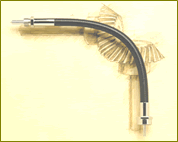Choosing READY-FLEX® Flexible Shafts Without Casing - With Couplings
These shafts are used for short distances in short duty cycle applications. They are designed for control type applications for transferring slow motion from one point to another. The shaft is unsupported by casing and therefore will not respond well to long lengths where it may tend to helix. Due to a lack of casing, it will not retain grease. These shafts should not be run at high speeds for long periods of time, as they will dry out, heat up, and fail.

Bi-Directional or Uni-Directional?
Uni-Directional (Power-FLEX™)
These shafts are designed for continuous operation, maximum torque carrying ability, and torsional stiffness in only one direction of rotation: either clockwise or anti-clockwise when viewed from the driving end. The performance of a Uni-directional shaft will fall off dramatically if operated in the opposite direction.
Bi-Directional (Steady-FLEX™)
These shafts are designed to rotate in both clockwise and anti-clockwise directions. They have more balanced physical properties that allow them to operate in either direction of rotation.

Torque Requirements
This is the maximum continuous torque (in-lb or N-m) that you will be transmitting through the shaft.
This will determine the diameter of the shaft required for your application.
Start up torques-or short duration peak torques- may safely be 20% higher.
If you are measuring your load in Horsepower, you must convert to in-lb using the Torque-Horsepower conversion chart , or use the following formula:
HP x 63,000
Torque = ---------------
RPM
Minimum Bend Radius
There is a direct relationship between operating torque and operating radius; as the radius gets smaller the torque capacity of the shaft reduces.
In tighter bends the wires rub against each other more forcefully increasing the friction, heat, and stress.
The minimum radius can be calculated using the following formula:
x ² + y ²
R = ----------
4x

Minimum Bend Radius
Charts to Select the Correct Shaft
Depending on your application's direction of rotation (see diagram above) and measurement units, click on the appropriate chart to choose the correct Flexible Shaft for your application:
Uni-Directional (English Units) chart
Uni-Directional (Metric Units) chart
Bi-Directional (English Units) chart
Bi-Directional (Metric Units) chart
Locate the column with your minimum bend radius in the charts. Start at the top, go down the column until you find the corresponding shaft diameter that is rated for your least torque load. If you click the link below the chart, you can see more specifications for that shaft.

Bending or Torsional Stiffness
If two or more types of shafts of the same diameter meet your torque requirements, it is desirable to choose the shaft with the lowest bending stiffness, since it correlates to lower "torque to rotate" which is a measure of the internal friction in the shaft.
If torsional deflection i.e. the shaft twisting under load is a concern, then look at the corresponding torsional stiffness values for the shafts that meet your torque and minimum radius requirements . From these, choose the shaft that best fits your deflection needs.
Operating Speed
This is the maximum continuous speed in RPM's for a shaft under load.
Check the Specification Charts to see that your speed is within the design limits of the shaft.
As the speed increases the level of power transmitted can increase as the torque load is reduced proportionally to the increase in the shaft speed.
From this you can see that Flexible Shafts like to be run fast so as to reduce torque load.
*Excessive speed, especially in tight bend radii for extended periods, can cause heat buildup and premature failure.
Length
Determine the proper length (in inches) of the overall shaft assembly by closely approximating all bends and offsets.
Measure the length along the centerline of the shaft.





